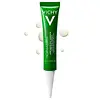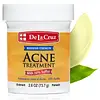What's inside
What's inside
 Key Ingredients
Key Ingredients

No key ingredients
 Benefits
Benefits

 Concerns
Concerns

 Ingredients Side-by-side
Ingredients Side-by-side

Sulfur
AntiseborrhoeicWater
Skin ConditioningNiacinamide
SmoothingZea Mays Starch
AbsorbentGlycolic Acid
BufferingStearyl Alcohol
EmollientGlycerin
HumectantOctyldodecyl Myristate
EmollientCetearyl Alcohol
EmollientGlyceryl Stearate
EmollientSodium Hydroxide
BufferingMagnesium Aluminum Silicate
AbsorbentPEG-100 Stearate
C13-14 Isoparaffin
EmollientAllantoin
Skin ConditioningCeteareth-20
CleansingPhenoxyethanol
PreservativePhenylethyl Resorcinol
AntioxidantTocopheryl Acetate
AntioxidantDisodium EDTA
Laureth-7
EmulsifyingHydrogenated Lecithin
EmulsifyingPolyacrylamide
Ethylhexylglycerin
Skin ConditioningSulfur, Water, Niacinamide, Zea Mays Starch, Glycolic Acid, Stearyl Alcohol, Glycerin, Octyldodecyl Myristate, Cetearyl Alcohol, Glyceryl Stearate, Sodium Hydroxide, Magnesium Aluminum Silicate, PEG-100 Stearate, C13-14 Isoparaffin, Allantoin, Ceteareth-20, Phenoxyethanol, Phenylethyl Resorcinol, Tocopheryl Acetate, Disodium EDTA, Laureth-7, Hydrogenated Lecithin, Polyacrylamide, Ethylhexylglycerin
 Reviews
Reviews

Ingredients Explained
These ingredients are found in both products.
Ingredients higher up in an ingredient list are typically present in a larger amount.
Sulfur is a commonly occurring element on Earth (and our universe!). In cosmetics, it helps kill bacteria, reduces sebum, and provides exfoliation. This makes it an effective ingredient to reduce breakouts and fight acne.
As a ketayolytic agent, it breaks down the top layer of skin. This is a form of exfoliation and may help decrease acne and hyperpigmentation.
Studies show sulfur has antibacterial and antifungal properties. Sulfur can be drying if used excessively or at higher concentrations. We recommend speaking with a medical professional if you have any concerns.
Ancient Greece, India, China, and Egypt have used sulfur in both traditional medicines and for household use.
Learn more about Sulfur